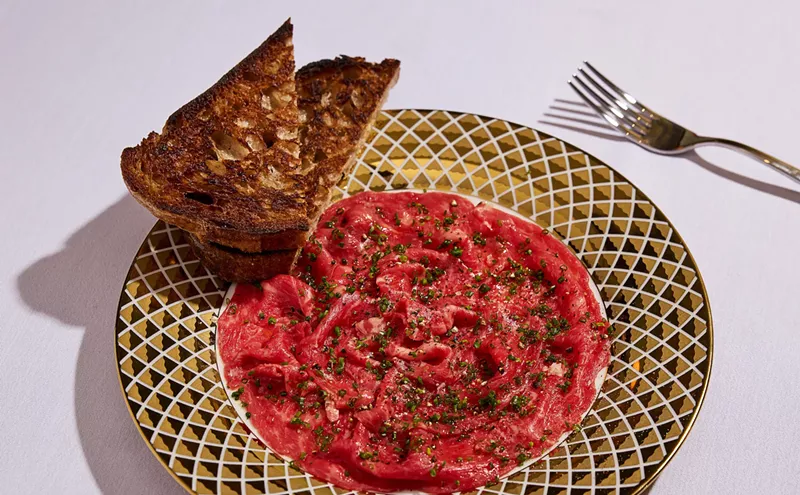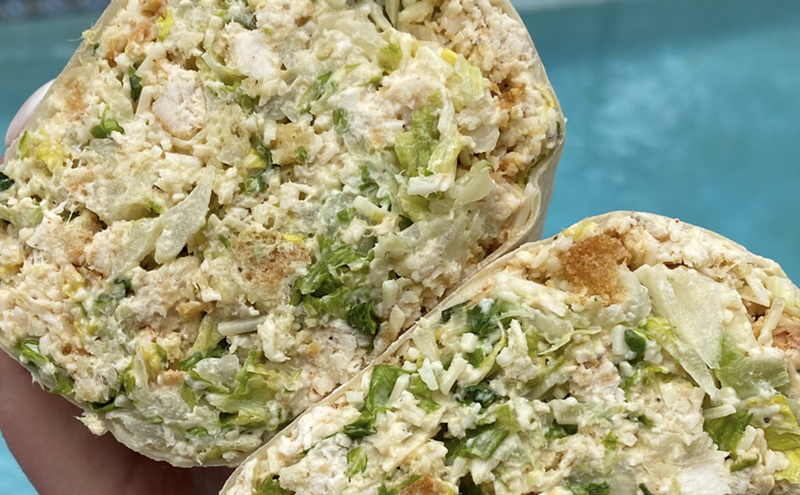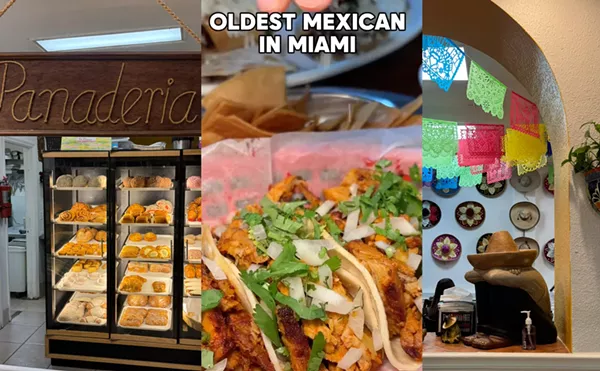Nothing is more frustrating for a fledgling gourmand than to be cut down in his or her prime by food allergies. The other night I arranged to meet two companions, a man and a woman, both of whom adore dining. The difficulty lay in choosing a restaurant. The man is highly allergic to eggs, dairy products, peanuts, and bananas; the woman can't eat anything made with wheat or sugar. Whatever spirit possessed me to entertain them simultaneously, it certainly didn't have a prodigious appetite. Unless we wanted our evening to include a trip to Jackson Memorial, our possibilities appeared to be limited.
In truth, though, I'm familiar with systemic reactions to foods. My sister, throughout her formative years, suffered a severe dairy-and-egg allergy. She became the only child among her friends to serve apple pie instead of cake at her birthday parties (typical pie crust contains no eggs). Naturally she was never happy about being cast as an oddball. Other friends of mine suffering from such maladies often feel similarly excluded, even as adults, and especially when dining out.
Most restaurants unwittingly discriminate against diners with special needs simply by not offering enough alternatives. And I'm uncomfortable downing fettuccine Alfredo in front of a man whose only choice is spaghetti marinara, or savoring chocolate cake in the presence of a woman whose dessert is restricted to black coffee. The guilt has nothing to do with the calories. It's the yearning in their faces I can't stand to see.
One option is to prepare dinner at home. But to many of us this is no option at all; dining out ranks among our most important social interactions. We communicate with each other through discussion of menu items; we show our trust by sharing dishes; we chat as we eat; we release aggressions by fighting over the bill. Through food we make contact. I knew a Californian who, when he discovered he could no longer tolerate sodium, made salt-free dinner dates at his house. His girlfriend eventually ditched him for a junk-food addict.
Health food restaurants are a logical solution. Those afflicted with allergies, digestive diseases, hypertension, and other diet-affected illnesses are welcomed at such places. Forget the refugee's first sight of the Freedom Tower; true liberation is feeling free to eat almost any item on the menu.
The number of health food restaurants in Miami is like a single drop of cream in a bechamel sauce: barely significant. But with the recent addition of Coconut Grove's Oak Feed Natural Foods Restaurant, finding a square seitan-and-tofu meal is, if not incredibly enticing, at least a little easier. Although a long-time staple for those seeking healthy groceries, Oak Feed only added the restaurant in March.
For the average Big Mac-and-fries consumer, Oak Feed can be an alien experience. An indoor/outdoor cafe on Grand Avenue, the restaurant is connected to the natural foods market that has been a Grove staple for many years. More so than the menu, it's the clientele that may seem unusual A the local chapter of the Hare Krishna frequents Oak Feed, as do the bald or bearded others of cultish or philosophical bent. All in the grand tradition of self-consciously "healthy" dining establishments, where the freaks meet to eat.
And the staff, judging from their enthusiasm for soy-based "cream" sauces and the inner goodness of wheat kernels, seem as likely to experience a metaphysical epiphany merely smelling the earthy servings as any customer would eating them.
But the menu here is ambitious, neatly overstepping the patchouli-and-Birkenstock stereotype so many of us cherish like Grateful Dead bootlegs. Influenced heavily by a gourmet interpretation of Japanese and other Eastern cuisines, the dinner menu abandons the typical soy cheese pizza, tofu stir fry, and seven-grain burger one expects to find (although a seasoned "wheatmeat" burger with caramelized onions is available for lunch). It seems that Sixties' flavors have taken, in the Nineties, a trippy turn to nouvelle cuisine.
At first glance the selections read like any other creative bistro's fare. Items such as the salmon carpaccio appetizer and the entree of rotini with smoked trout, sun-dried tomatoes, fresh dill, and oil-cured black olives could be Grove-universal specialties. Until you realize that the cream sauce in which the rotini is served is completely nondairy, as is the entire menu.
The nod to nouvelle, however, wasn't enough to allow me to forget where, and what, I was eating. The name Oak Feed has always meant horses to me. It sounds like a hitching post, where bags of oats might be strapped onto our obedient chins, and we munch the bland grains until someone takes them away. This image was only reinforced by my fava bean pƒte starter, a tasteless grind of fleshy beans accented by an occasional pistachio nut and a nugget of roasted red pepper. Supposedly bourbon-scented, I found this dish to be a rough approximation of the acorn patties I used to "bake" in the back yard of my childhood. Nor was it helped by the gelatinous slivers of vegetable aspic that accompanied it, a jellyfish-colored condiment so deficient in flavor I questioned its purpose on the plate. But another condiment, dill-cured pickled onion, was a success, lending a tease of vinegar to the staid legume mash.
The black bean pancake, an appetizer similarly lacking in finesse, needed to have been cooked with salt. Black beans are notorious for their powers of absorption; I always salt mine heavily to avoid a telltale taste of paste. Even the addition of salt (though not on the table, salt shakers are willingly supplied, and without surprise) couldn't sell us on this dish. With the touch of tofu sour cream and tomato-cilantro relish, the blini attained, if not perfection, at least some promise.
The most finely tuned appetizer was the meaty portobello mushroom, grilled and sliced like a filet on herbed garlic toast. Mushrooms as large as the portabella have always frightened me, ever since I read The Story of Babar, in which the King of the Elephants turns green and dies after consuming a big, bad mushroom. But I have by now made them my friends, and they delight me with a supple, chewy texture. Oak Feed's version, a bit too oily, was nonetheless generous with juice and an intriguing, hearty touch of the earth.
Deciding whether to dine at Oak Feed depends on how you view "health" food. One of my dining partners delightedly ordered tofu vegetable lasagna, having been deprived by his allergies of the genuine version for some time now. He savored the miso herb vinaigrette that dressed the companion salad, a light, sharp barb of seasonings cratered in the lettuce's verdant valleys. But he was disappointed by the lasagna itself, a failed casserole he had presumed would taste like the lasagna of old, and instead just tasted old. His mistake was unrealistic anticipation; Oak Feed's mistake was too much tofu, not enough marinara.
The greatest attribute of tofu, a nutritious soybean curd, is its ability to act as a blank canvas for a palette of other flavors. This makes the versatile product a popular, nutritious ingredient. But contrary to the tide of opinion, tofu does have a mild taste of it own. In the case of the lasagna, the tofu was emphasized when it should have been acting merely as texture. With my steamed vegetables in a coconut curry sauce, however, the tofu was marinated and appropriately noteworthy. For me the tofu wasn't a substitute but a rewarding experience all its own. I should note, though, that the coconut curry sauce, being an honest version, isn't exactly a healthy choice; coconut milk contains a high amount of calories.
My wheat-free friend devoured the "lovely" (her word) nori-blackened dolphin. Nori is a sea vegetable, dried and pressed into sheets, commonly used to wrap sushi. This vitamin-rich garment can also be toasted, which makes it dry and crumbly. Using nori to blacken fish is an idea the Cajuns certainly would scorn, but nutritionally speaking, it's an excellent coating for fish.
Over frozen fruitage -- a sugar-free, lactose-free dessert that tastes as if it contains great amounts of both -- the conversation logically turned to philosophies. Cued by the Eastern-influenced cuisine, we discussed the benefits of yoga, meditation, and self-healing. I admit there are certain merits to every belief. But I can't help being a bit skeptical, or as my wheat-free friend suggests, listening to my intellect instead of my body. Whatever. I did attempt yoga once, a spiritual aerobics class that cramped my midsection. Let's hope vegetable aspic doesn't have the same effect.











